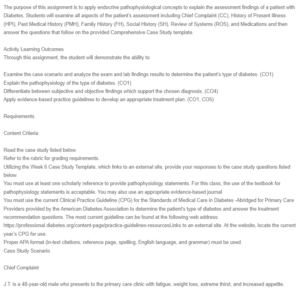Question The purpose of this assignment is to apply endocrine pathophysiological concepts to explain the assessment findings of a patient with Diabetes. Students will examine all aspects of the patient’s assessment including Chief Complaint (CC), History of Present Illness (HPI), Past Medical History (PMH), Family History (FH), Social History (SH), Review of Systems (ROS), and Medications and then answer the questions that follow on the provided Comprehensive Case Study template.
Question
The purpose of this assignment is to apply endocrine pathophysiological concepts to explain the assessment findings of a patient with Diabetes. Students will examine all aspects of the patient’s assessment including Chief Complaint (CC), History of Present Illness (HPI), Past Medical History (PMH), Family History (FH), Social History (SH), Review of Systems (ROS), and Medications and then answer the questions that follow on the provided Comprehensive Case Study template.Activity Learning Outcomes Through this assignment, the student will demonstrate the ability to: Examine the case scenario and analyze the exam and lab findings results to determine the patient’s type of diabetes. (CO1) Explain the pathophysiology of the type of diabetes. (CO1) Differentiate between subjective and objective findings which support the chosen diagnosis. (CO4) Apply evidence-based practice guidelines to develop an appropriate treatment plan. (CO1, CO5) Requirements Content Criteria Read the case study listed below. Refer to the rubric for grading requirements. Utilizing the Week 6 Case Study Template, which links to an external site, provide your responses to the case study questions listed below. You must use at least one scholarly reference to provide pathophysiology statements. For this class, the use of the textbook for pathophysiology statements is acceptable. You may also use an appropriate evidence-based journal. You must use the current Clinical Practice Guideline (CPG) for the Standards of Medical Care in Diabetes -Abridged for Primary Care Providers provided by the American Diabetes Association to determine the patient’s type of diabetes and answer the treatment recommendation questions. The most current guideline can be found at the following web address: https://professional.diabetes.org/content-page/practice-guidelines-resourcesLinks to an external site. At the website, locate the current year’s CPG for use. Proper APA format (in-text citations, reference page, spelling, English language, and grammar) must be used. Case Study Scenario Chief Complaint J.T. is a 48-year-old male who presents to the primary care clinic with fatigue, weight loss, extreme thirst, and increased appetite. History of Present Illness J.T. was in his usual state of health until three weeks ago, when he began experiencing symptoms of fatigue, weight loss, and extreme thirst. He reports that he would like to begin a walking program, but he feels too fatigued to walk at any point during the day. Now he is very concerned about gaining more weight since he is eating more. He reports insomnia due to having to get up and urinate greater than 4 times per night. Past Medical History Hypertension Hyperlipidemia Obesity Family History Both parents deceased Brother: Type 2 diabetes Social History Denies smoking Denies alcohol or recreational drug use Landscaper Allergies No Known Drug Allergies Medications Lisinopril 20 mg once daily by mouth Atorvastatin 20 mg once daily by mouth Aspirin 81 mg once daily by mouth Multivitamin once daily by mouth Review of Systems Constitutional: – fever, – chills, – weight loss. Neurological: denies dizziness or disorientation HEENT: Denies nasal congestion, rhinorrhea, or sore throat. Chest: (-)Tachypnea. Denies cough. Heart: Denies chest pain, chest pressure, or palpitations. Lymph: Denies lymph node swelling. General Physical Exam Constitutional: Alert and oriented male in no acute distress Vital Signs: BP-136/80, T-98.6 F, P-78, RR-20 Wt. 240 lbs., Ht. 5’8″, BMI 36.5 HEENT Eyes: Pupils are equal, round, and reactive to light and accommodation, with normal conjunctiva. Ears: Tympanic membranes intact. Nose: Bilateral nasal turbinates without redness or swelling. Nares patent. Mouth: Oropharynx clear. No mouth lesions. Teeth present and intact; Oral mucous membranes and lips dry. Neck/Lymph Nodes Neck supple without JVD. No lymphadenopathy, masses, or carotid bruits. Lungs Bilateral breath sounds clear throughout lung fields. Breathing quality deep with fruity breath odor Heart S1 and S2 have regular rates and rhythms, tachycardia, and no rubs or murmurs. Integumentary System Skin warm and dry; Nail beds pink without clubbing. Labs Test Patient’s Result Reference Glucose (fasting) 132 60-120 mg/dL BUN 20 7-24 mg/dL Creatinine 0.8 0.7-1.4 mg/dL Sodium 141 135-145 mEq/L Sodium 141 135-145 mEq/L Chloride 97 95-105 mEq/L HCO3 24 22-28 mEq/L A1C 7.2 Urinalysis Protein Glucose Ketones Negative Positive Negative Oral glucose tolerance test (OGTT) 220 mg/dL J.T. is diagnosed with diabetes. Review all information provided in the case to answer the following questions. Case Study Questions Pathophysiology & Clinical Findings of the Disease Review the lab findings and decide if the diagnosis is Type 2 or Type 1 Diabetes Mellitus. Explain the pathophysiology associated with your chosen diagnosis Identify at least three subjective findings from the case that support the chosen diagnosis. Identify at least three objective findings from the case that support the chosen diagnosis. Management of the Disease *Utilize the required Clinical Practice Guideline (CPG) to support your treatment recommendations. Identify two (2) “Evidence A” recommended medication classes for the treatment of this condition and provide an example (drug name) for each. Describe the mechanism of action for each of the medication classes identified above. Identify two (2) “Evidence A” recommended non-pharmacological treatment options for this patient. Utilizes the required Clinical Practice Guideline (CPG) to support the chosen treatment recommendations
Pathophysiology and Clinical Findings of the Disease – Diabetes
Our Advantages
- Quality Work
- Unlimited Revisions
- Affordable Pricing
- 24/7 Support
- Fast Delivery
Order Now